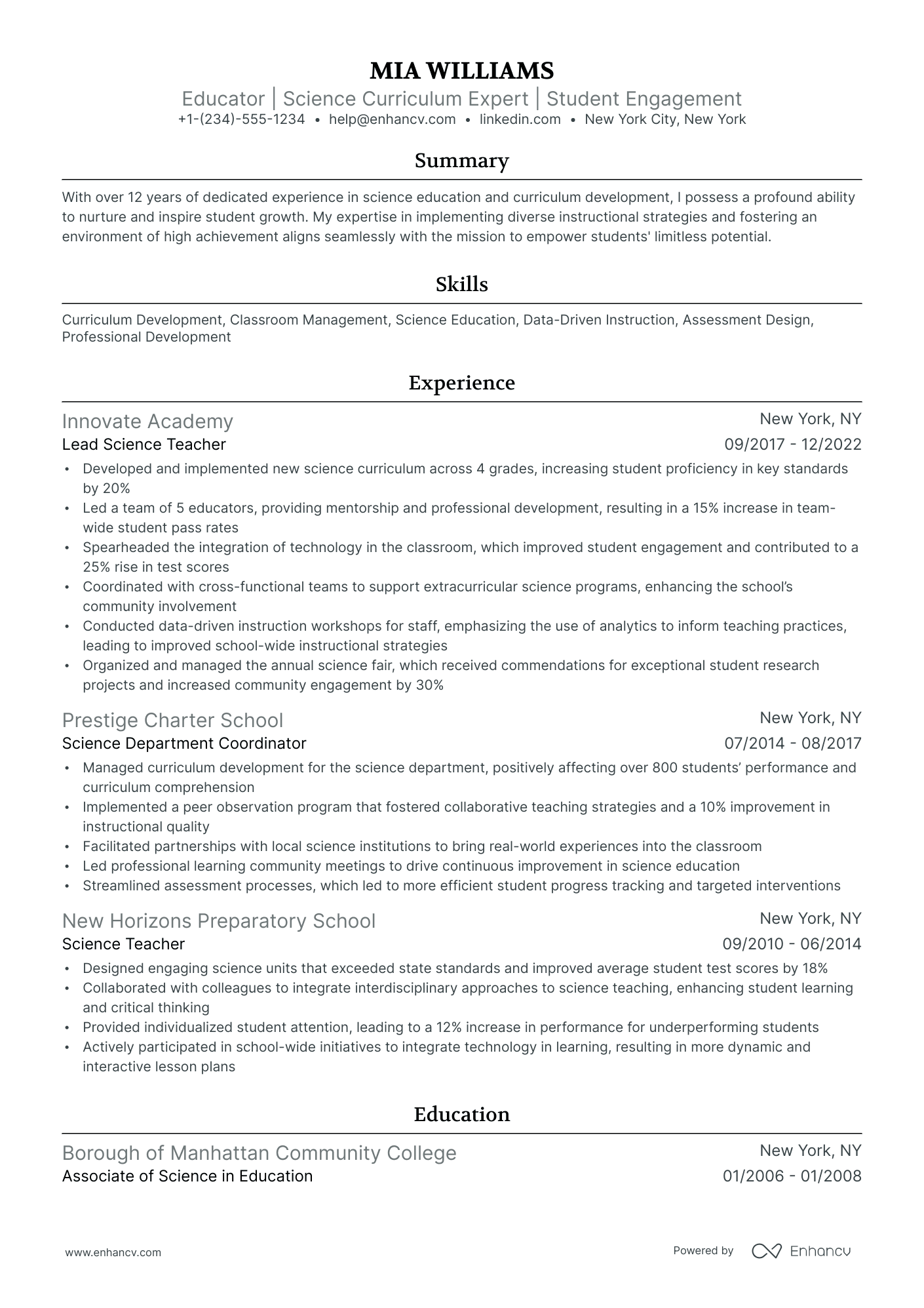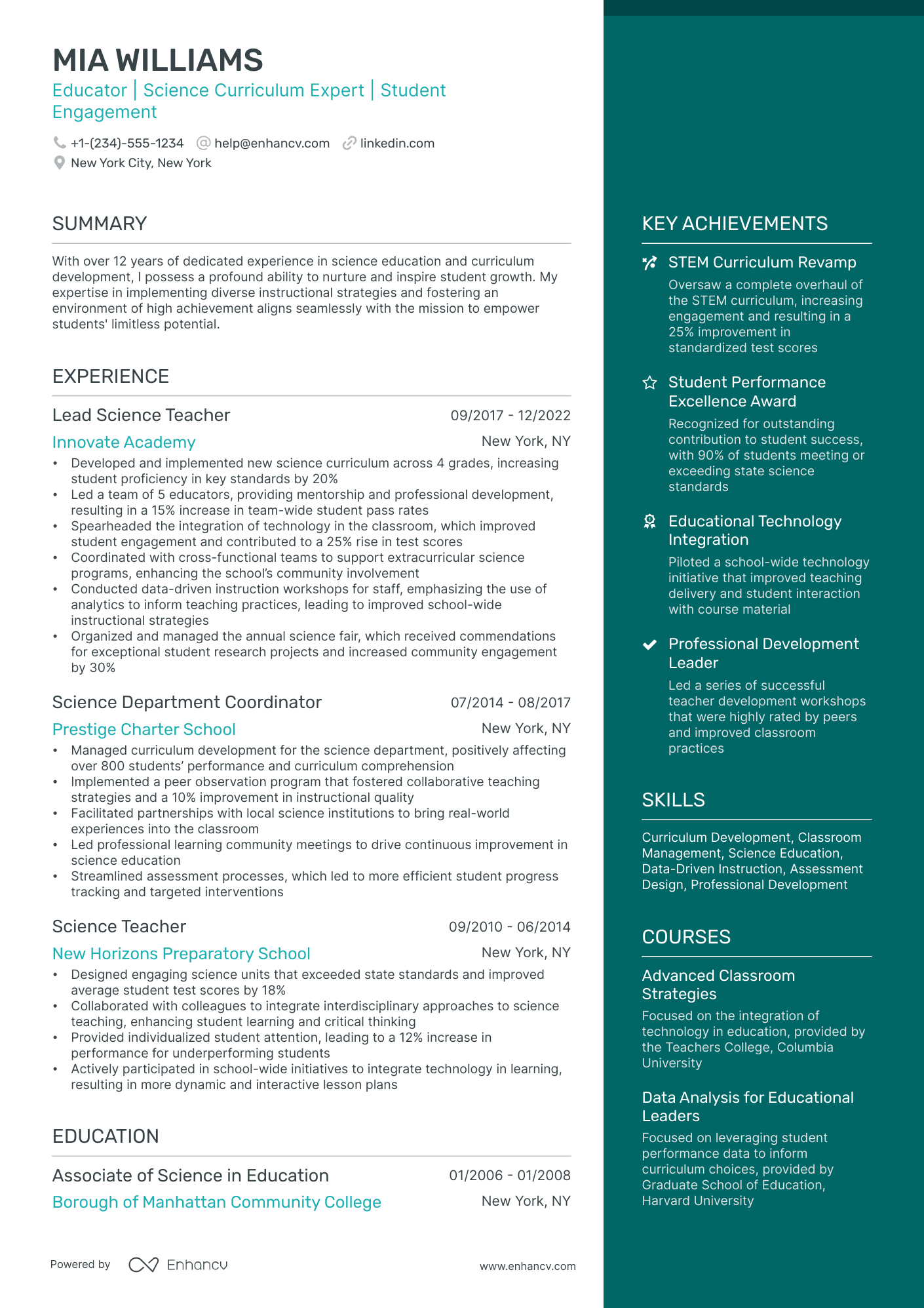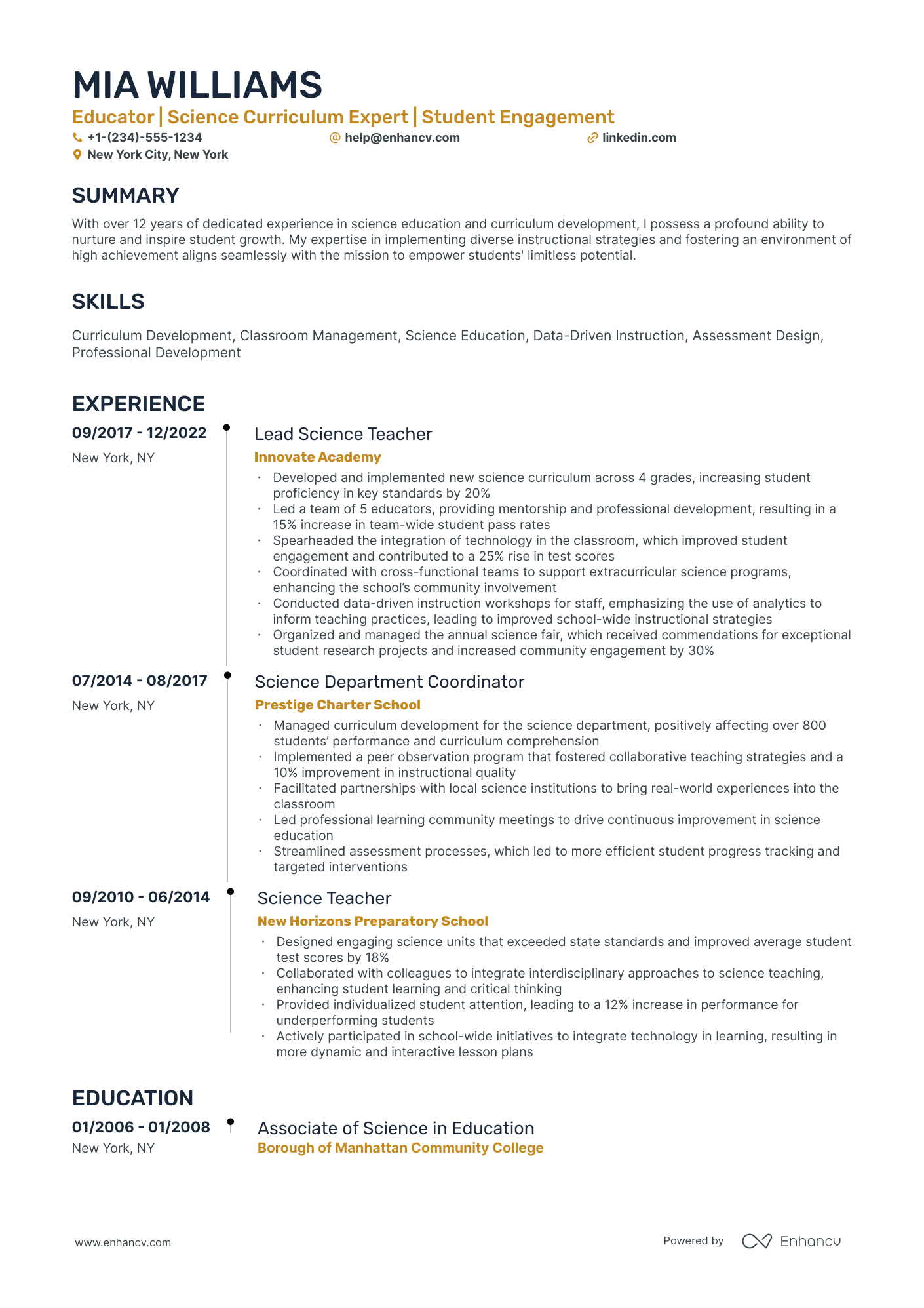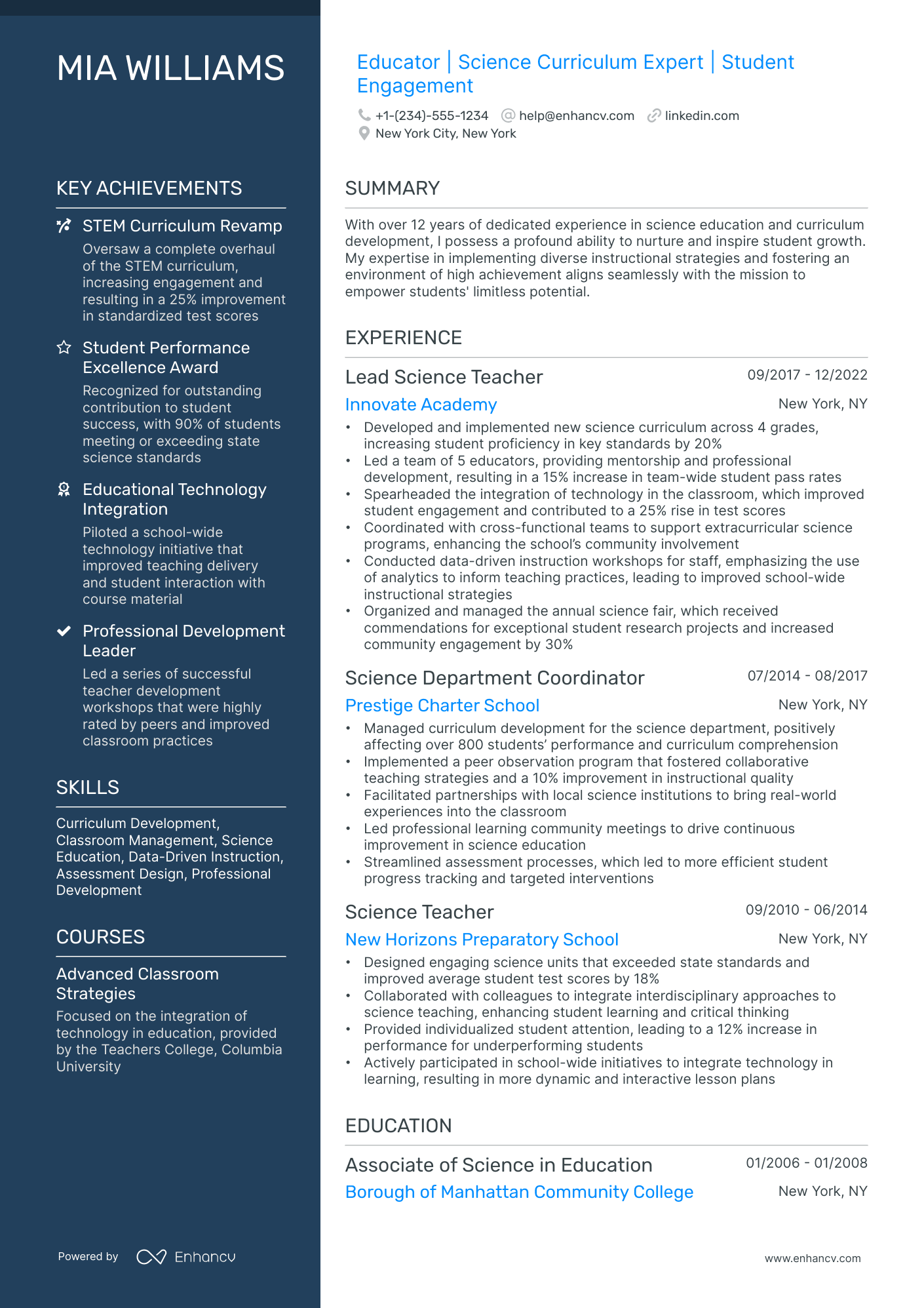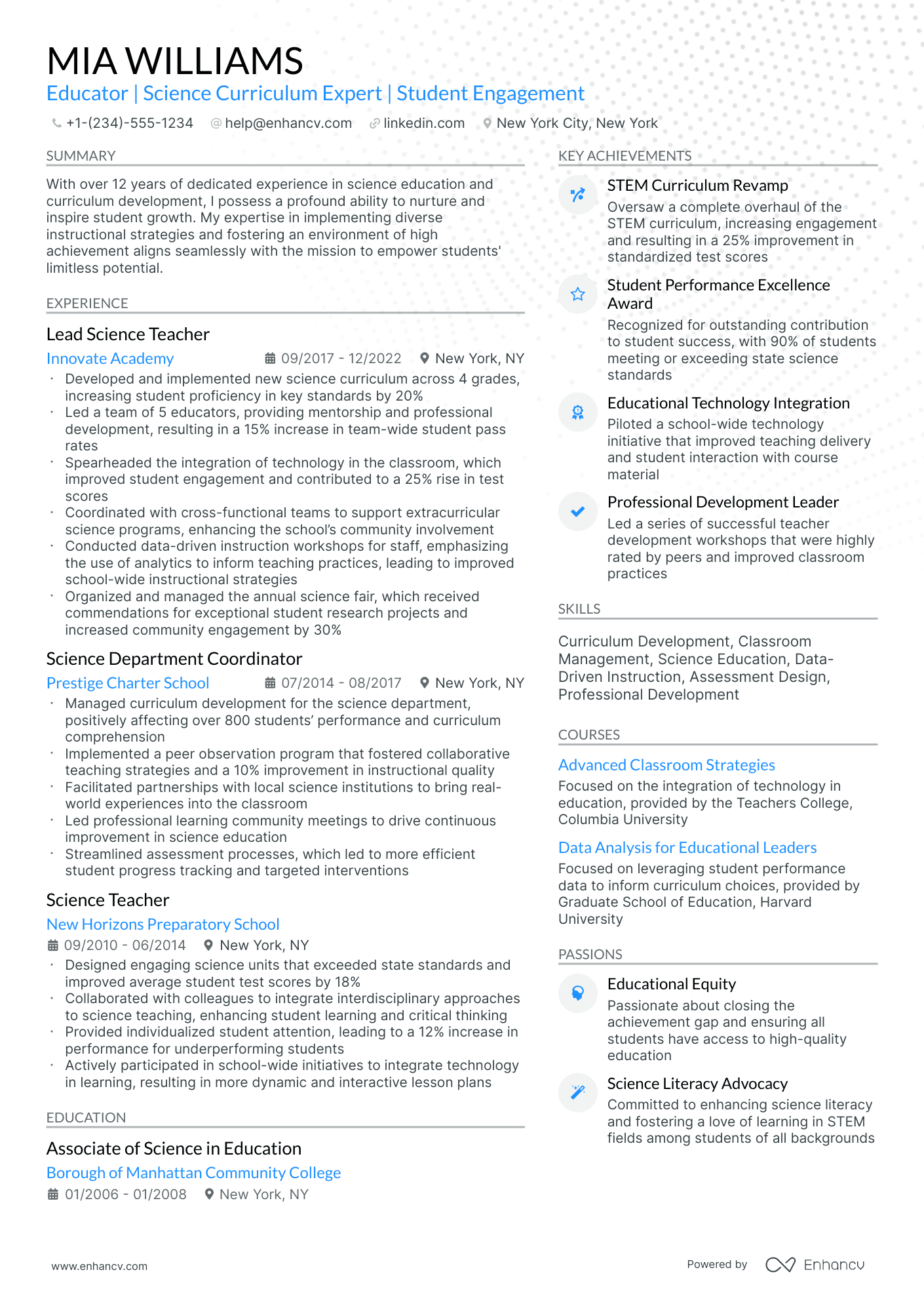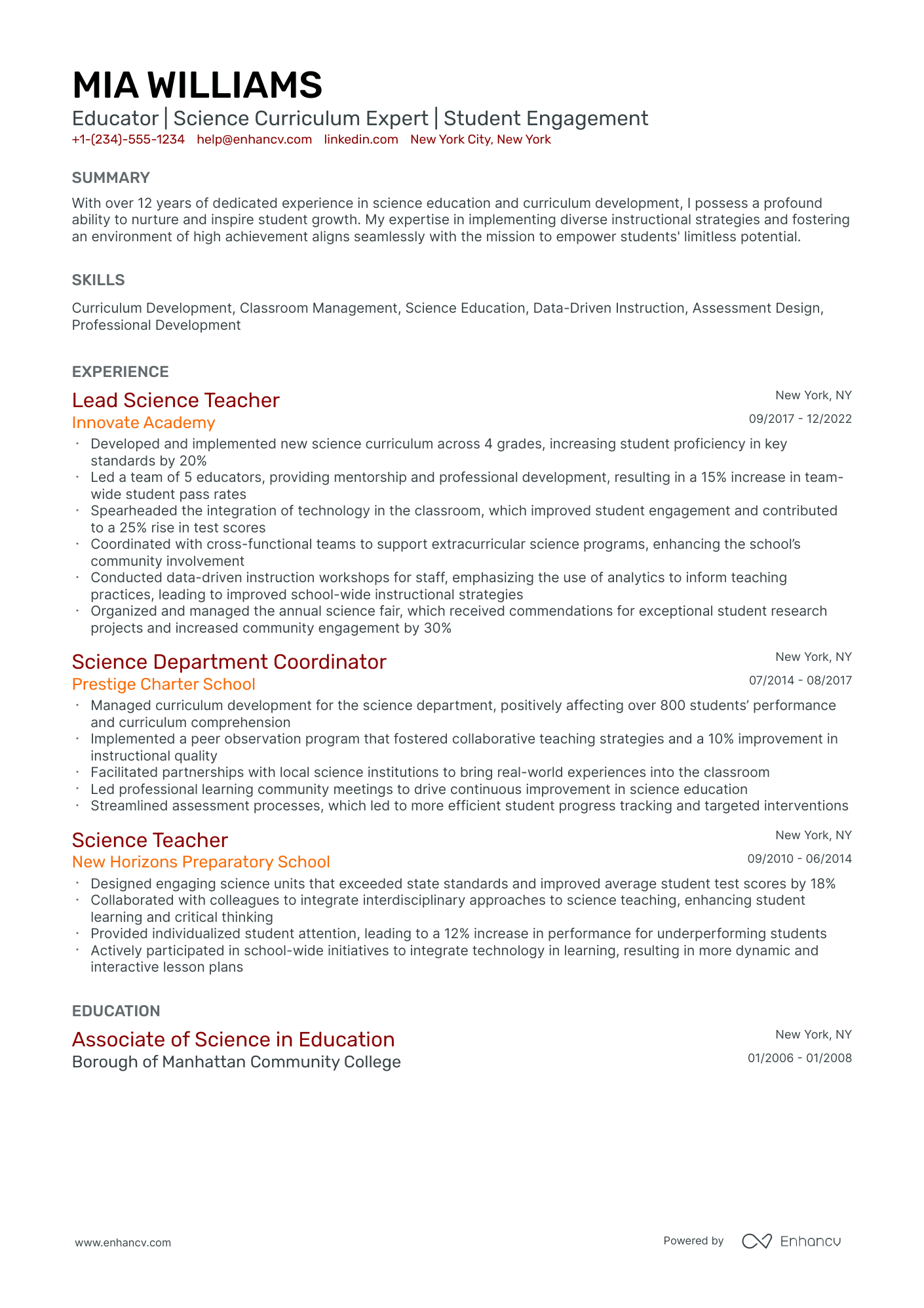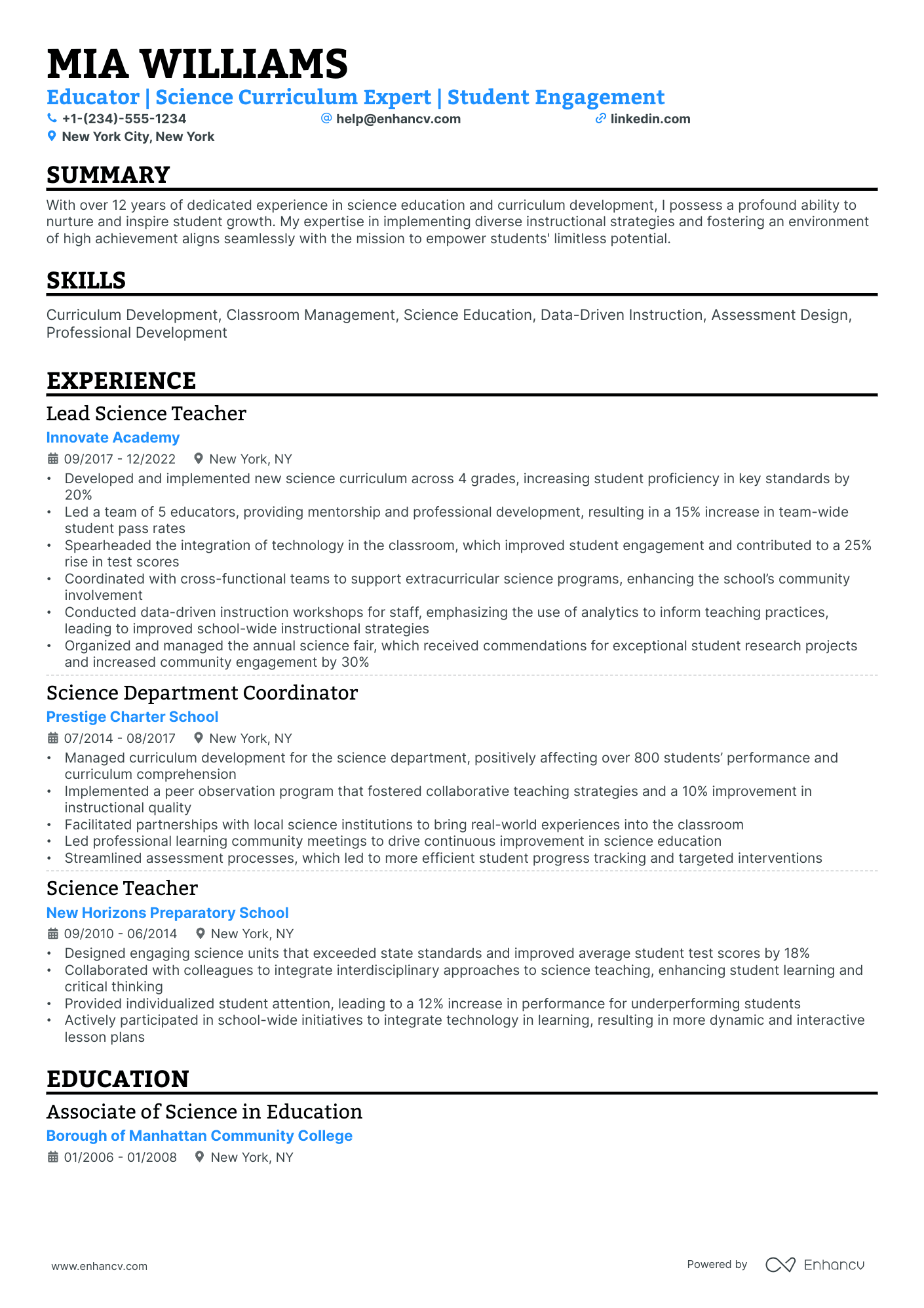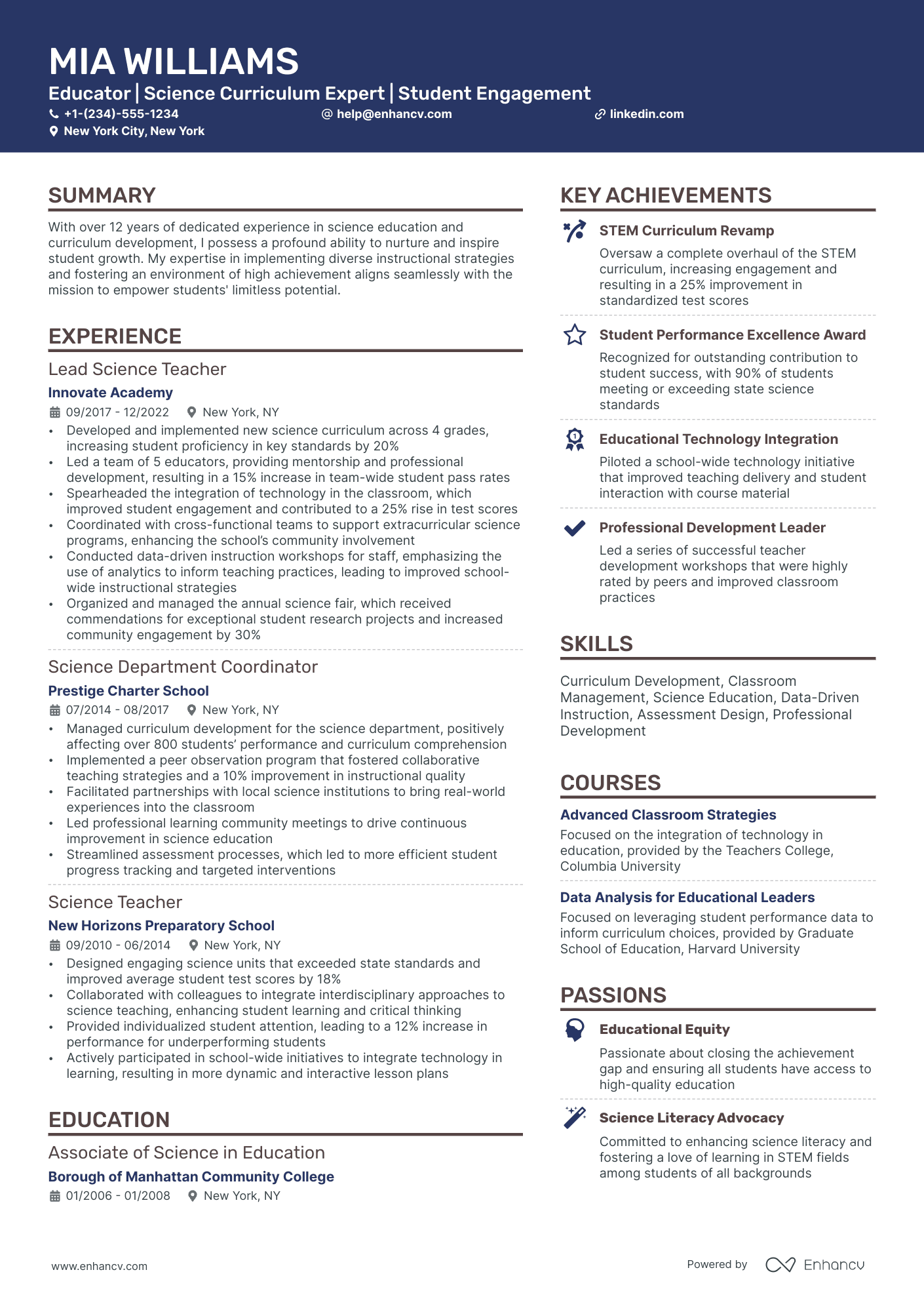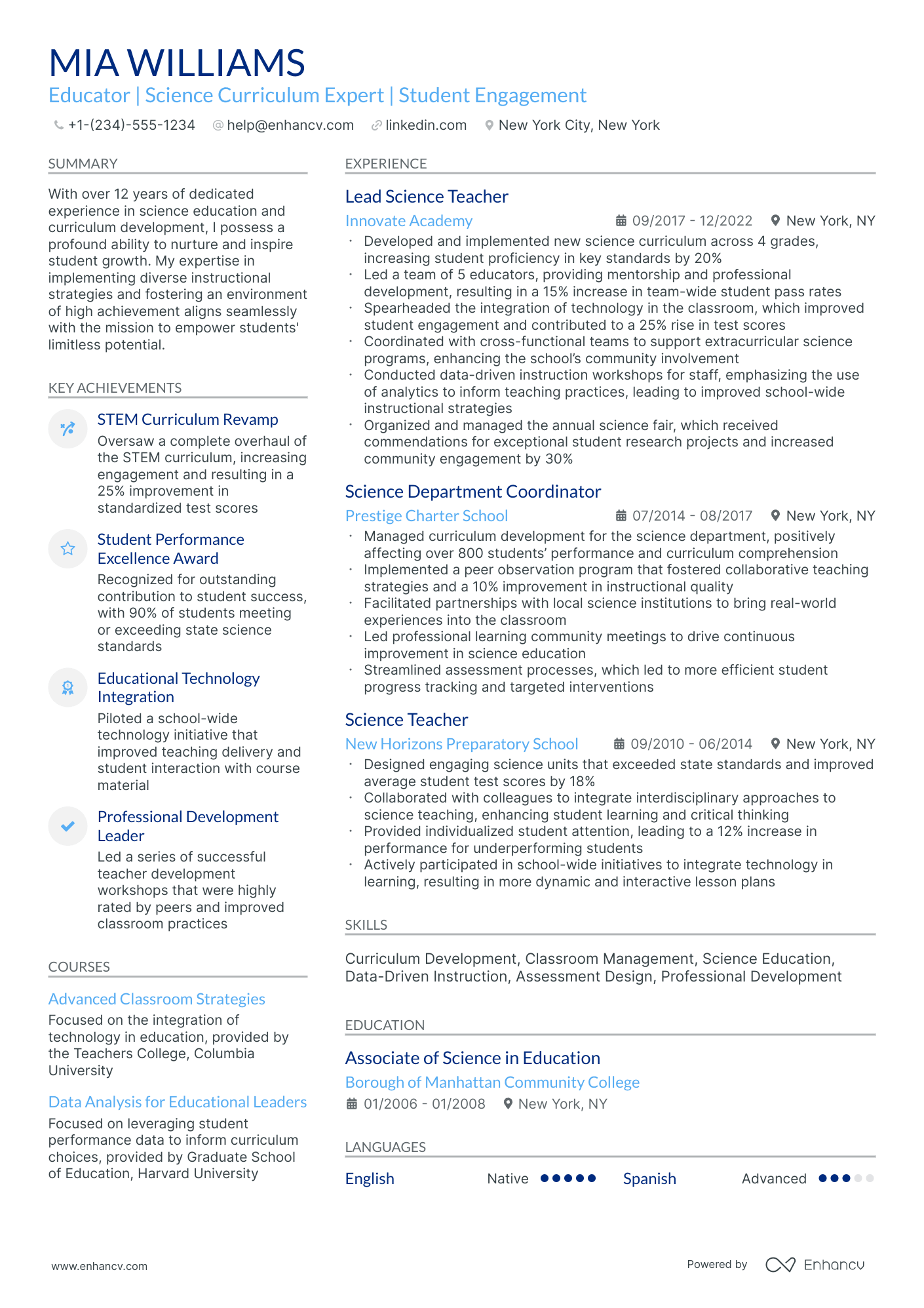As a science teacher, articulating your diverse laboratory experience and ability to manage a classroom on a resume can be a daunting task. Our guide offers tailored strategies to help you translate your scientific expertise and educational skills into a compelling resume that stands out to employers.
- Science teacher resume samples that got people hired at top companies.
- How to perfect the look-and-feel of your resume layout.
- How to showcase your achievements and skills through various resume sections.
- How you could hint to recruiters why your resume is the ideal profile for the job.
If the science teacher resume isn't the right one for you, take a look at other related guides we have:
- Bilingual Teacher Resume Example
- Pre K Teacher Resume Example
- Paraprofessional Resume Example
- Dance Teacher Resume Example
- After School Teacher Resume Example
- Preschool Assistant Teacher Resume Example
- Spanish Teacher Resume Example
- Lecturer Resume Example
- Math Teacher Resume Example
- Kindergarten Teacher Resume Example
How to style your science teacher resume: layout and format
When creating your science teacher resume, have you ever wondered how long it should be? Experts point out that it should be between one and two pages. Choose the longer format, if you happen to have over a decade of relevant experience. What is more, resume formats play a crucial role in presenting your experience. Use the:- Reverse-chronological resume format to highlight your experience;
- Functional skill-based resume format if you have less experience and want to focus on skills;
- Hybrid resume format to guide recruiters through both your experience and skills.
- Make sure your headline is simple and includes the job you're applying for or your current role, an abbreviation of a certificate you have, or even your professional area of interest;
- Always tailor your science teacher resume to the role you're applying for by matching job requirements to your experience via different resume sections;
- Once you've created your resume, download it in PDF (unless otherwise specified). This is to ensure readability and that the layout remains fixed.
Customize your resume for the market – a Canadian format, for example, might vary in structure.
Upload & Check Your Resume
Drop your resume here or choose a file. PDF & DOCX only. Max 2MB file size.
PRO TIP
If the certificate you've obtained is especially vital for the industry or company, include it as part of your name within the resume headline.
Recruiters' preferred science teacher resume sections:
- A header with relevant contact information and headline, listing your current job title
- A resume summary or objective pinpointing what is most impressive about your expertise (that aligns with the role)
- An experience section highlighting the specifics of your responsibilities and achievements
- A skills sidebar to intertwine job advert keywords with your unique talents
- An education and certifications sections to serve as further accreditation to your professional experience
What recruiters want to see on your resume:
- Demonstrated expertise in various scientific disciplines such as biology, chemistry, physics, and earth sciences
- Experience with lab equipment and safety procedures
- Ability to design and implement engaging and educational science curriculum that aligns with education standards
- Proven track record of fostering a classroom environment conducive to active learning and critical thinking
- Experience with educational technology and integration of digital tools into the science classroom
The science teacher resume experience section: a roadmap to your expertise
The resume experience section provides you with an opportunity to tell your professional narrative.
Recruiters, reading between the lines of your resume, use the experience section to better understand your unique skill set, accomplishments, and what unique value you bring about.
Discover five quick steps on how to write your experience section:
- Curate only relevant experience items to the role and include the company, description, and dates; all followed by up to six bullets per experience item;
- Each experience item should feature tangible results of your actions - if you can include a number or percent, this will further highlight your aptitude;
- If you've received any managerial or customer feedback, use short excerpts of it as further social proof of your technical or people skills;
- Make sure you're using the appropriate verb tense when listing your responsibilities;
- Within the description for each role, you could summarize your most noteworthy and relevant achievements.
Now, take note of how a real-world science teacher professional received opportunities at industry leaders with these resume experience sections:
- Initiated and coordinated annual Science Symposium, increasing student engagement in science projects by 40%.
- Developed and implemented an interdisciplinary curriculum that raised standardized test scores by 15% over a two-year period.
- Mentored a team of 5 novice science teachers, improving instructional strategies and contributing to a 20% improvement in overall science department performance.
- Leveraged technology by integrating simulation software, which led to a 25% increase in student comprehension of complex scientific concepts.
- Secured a $30,000 grant for the science department, enabling the acquisition of advanced lab equipment that broadened experimental learning opportunities.
- Orchestrated a community-based environmental conservation project involving 100+ students, fostering a connection between theoretical knowledge and real-world application.
- Piloted a student-led research program that culminated in 3 student awards at the State Science Fair.
- Collaborated with 10+ teachers across departments to facilitate a cross-curricular teaching approach that enriched educational outcomes.
- Implemented formative assessment strategies that saw a consistent year-over-year student pass rate improvement of 10%.
- Designed and executed an extracurricular robotics program which garnered a second-place win at the National Science Bowl.
- Authored and received approval for a new earth science elective, attracting over 80 students in the first year.
- Instituted a peer tutoring program that increased student performance within the lower percentile by 30%.
- Enhanced the science curriculum with a focus on biotechnology, preparing students for emerging science and technology fields.
- Spearheaded the integration of a lab-centric instructional approach, which boosted hands-on learning experiences by 50%.
- Chaired the school's Science Fair Committee, resulting in a 20% increase in student participation.
- Launched a successful after-school science program for underrepresented students, which helped close the achievement gap by 20%.
- Authored a digital interactive textbook adopted by the entire school district, enhancing student engagement and understanding.
- Partnered with local universities to provide students with access to cutting-edge lab facilities and mentorship opportunities.
- Trained in Next Generation Science Standards (NGSS) to revitalize science teaching methodologies, increasing lesson effectiveness.
- Coordinated year-long student participation in the 'Young Environmental Scientists Conference', where students presented research to industry experts.
- Facilitated the growth of the school's science club to include over 150 members, emphasizing collaborative and student-led projects.
- Utilized virtual reality tools to create immersive science learning experiences, enhancing student’s spatial understanding of molecular structures by 35%.
- Directed a student-centered inquiry-based learning initiative that improved critical thinking skills in the classroom.
- Developed a professional development program for science faculty focusing on active learning, benefiting over 20 teachers annually.
Quantifying impact on your resume
- Include the number of students taught per semester to demonstrate classroom management and the ability to handle workload.
- List the average percentage improvement in student test scores to show effectiveness in raising academic performance.
- Mention the number of science fairs or competitions organized to demonstrate project management and event coordination skills.
- Quantify the amount of educational materials developed, showing content creation expertise and curriculum development.
- Specify the percentage of students who pursued higher education in science, indicating inspirational and motivational skills.
- Detail the number of teacher training workshops attended to highlight commitment to professional development.
- State the amount of funding received for school science projects to showcase the ability to acquire resources and grants.
- Report the number of educational partnerships established with external organizations, evidencing networking and collaboration skills.
Action verbs for your science teacher resume
Science teacher resume without experience: a walk-through guide
If you don't happen to have any relevant experience yet, you can substitute this with:
- Short-term gigs and stunts - like month-long internships, that you have done during your university days
- Contract work - be specific about the relevance and outcomes of each role you include
- Resume format that prioritizes your skills - the functional-skill-based format or hybrid format could work
- Research roles - feature those especially prominently if you've participated in a noteworthy project or your role was of utmost importance to the project's success.
Recommended reads:
PRO TIP
List your educational qualifications and certifications in reverse chronological order.
Featuring your hard skills and soft skills on your science teacher resume
The skills section of your science teacher resume needs to your various capabilities that align with the job requirements. List hard skills (or technical skills) to showcase to potential employers that you're perfectly apt at dealing with technological innovations and niche software. Meanwhile, your soft skills need to detail how you'd thrive within your new, potential environment with personal skills (e.g. resilience, negotiation, organization, etc.) Your science teacher resume skills section needs to include both types of skills to promote how you're both technical and cultural fit. Here's how to create your bespoke science teacher skills section to help you stand out:
- Focus on skill requirements that are listed toward the top of the job advert.
- Include niche skills that you've worked hard to obtain.
- Select specific soft skills that match the company (or the department) culture.
- Cover some of the basic job requirements by including important skills for the science teacher role - ones you haven't been able to list through the rest of your resume.
Get inspired with our science teacher sample skill list to list some of the most prominent hard and soft skills across the field.
Top skills for your science teacher resume:
Laboratory Equipment Proficiency
Curriculum Development Software
Data Analysis Tools (e.g., Excel, SPSS)
Simulations Software (e.g., PhET, Labster)
Interactive Whiteboards
Science Experiment Kits
Assessment Tools (e.g., Google Forms, Kahoot)
Online Learning Platforms (e.g., Google Classroom, Edmodo)
Presentation Software (e.g., PowerPoint, Prezi)
Safety Procedures and Protocols
Communication Skills
Patience
Creativity
Adaptability
Classroom Management
Collaboration
Critical Thinking
Problem-Solving
Empathy
Motivational Skills
PRO TIP
If you failed to obtain one of the certificates, as listed in the requirements, but decide to include it on your resume, make sure to include a note somewhere that you have the "relevant training, but are planning to re-take the exams". Support this statement with the actual date you're planning to be re-examined. Always be honest on your resume.
The importance of your certifications and education on your science teacher resume
Pay attention to the resume education section . It can offer clues about your skills and experiences that align with the job.
- List only tertiary education details, including the institution and dates.
- Mention your expected graduation date if you're currently studying.
- Exclude degrees unrelated to the job or field.
- Describe your education if it allows you to highlight your achievements further.
Your professional qualifications: certificates and education play a crucial role in your science teacher application. They showcase your dedication to gaining the best expertise and know-how in the field. Include any diplomas and certificates that are:
- Listed within the job requirements or could make your application stand out
- Niche to your industry and require plenty of effort to obtain
- Helping you prepare for professional growth with forward-facing know-how
- Relevant to the science teacher job - make sure to include the name of the certificate, institution you've obtained it at, and dates
Both your certificates and education section need to add further value to your application. That's why we've dedicated this next list just for you - check out some of the most popular science teacher certificates to include on your resume:
The top 5 certifications for your science teacher resume:
- National Board Certification (NBC) - National Board for Professional Teaching Standards (NBPTS)
- Secondary science teacher Certification - Specific State Department of Education (varies by state)
- Praxis Subject Assessments (Praxis) - Educational Testing Service (ETS)
- Science Education Certification (SEC) - National science teachers Association (NSTA)
- Professional Educator License (PEL) - Specific State Board of Education (varies by state)
PRO TIP
The more trusted the organization you've attained your certificate (or degree) from, the more credible your skill set would be.
Recommended reads:
Best practices to your science teacher resume summary or objective
To start, how do you know if you should include a resume summary or a resume objective ?
- Resume summaries are ideal for science teacher professionals with more experience, who'd like to give a quick glimpse of their biggest career achievements in the top one-third of their resumes.
- On the other hand, resume objectives serve as a road map for recruiters. Candidates use the objective to show how their experience aligns with the science teacher role they're applying for while showcasing the North Star of their career (or where they want to be as a professional in the next couple of years).
The resume summary or resume objective could be the perfect fit for your science teacher resume. The function of both is to highlight your professionalism succinctly. So, keep your writing specific: include no more than four sentences and target your application to the role. Here's how these specific resume sections help the science teacher candidates stand out.
Resume summaries for a science teacher job
- With over 8 years of dedicated experience as a senior high school biology teacher, I have developed a robust expertise in crafting engaging curricula that align with state standards and ignite student passion for science. I'm particularly proud of leading the Science Fair initiative, which has seen a 40% increase in student participation.
- Seasoned chemistry educator with 10 years of experience in fostering a rigorous academic environment for advanced placement students. Recognized for integrating technology to enhance classroom learning, I have also facilitated numerous successful student-led research projects published in local journals.
- Transitioning from a decade of corporate pharmaceutical research to science education, I bring a practical understanding of chemistry and biology to foster real-world connections for students. My expertise in laboratory management and safety protocols will enrich the learning environment and contribute to the academic excellence of the institute.
- After 15 years in environmental consultancy, I aim to transition my extensive fieldwork experience into the classroom as a science teacher. With in-depth knowledge of ecological systems, I am prepared to offer students unique insights into current environmental challenges and engage them in solution-oriented learning.
- Seeking to leverage my fresh enthusiasm as a new graduate with a Master's in Physics and a concentration in education, my objective is to cultivate a dynamic classroom atmosphere where theoretical physics concepts are made tangible through innovative experiments and interactive learning strategies.
- As a recent biology graduate with a passion for education and a certification in secondary education, my goal is to inspire a new generation of students with engaging lesson plans and hands-on experiments that showcase the wonders and workings of the natural world.
Optimize your resume summary and objective for ATS
Drop your resume here or choose a file.
PDF & DOCX only. Max 2MB file size.
Bonus sections for your science teacher resume
Looking to show more personality on your science teacher resume? Then consider including a couple of extra sections.
They'd benefit your application by highlighting your most prominent:
Key takeaways
- Your science teacher resume is formatted professionally and creates an easy-to-read (and -understand) experience for recruiters;
- You have included all pertinent sections (header, summary/objective, experience, skills, certifications) within your science teacher resume;
- Instead of just listing your responsibilities, you've qualified them with skills and the results of your actions;
- Within your science teacher resume, you've taken the time to align specific job requirements with your unique expertise, showcasing the value you can provide as a professional;
- Technologies and personal skills are featured across different sections of your science teacher resume to achieve the perfect balance.
